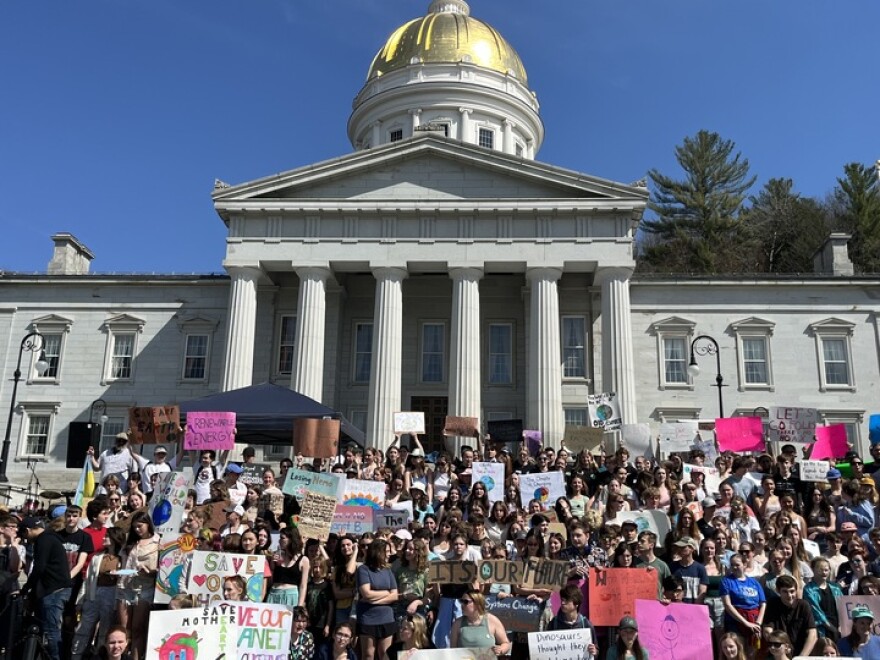This story has been updated.
New modeling from the state suggests that absent major policy solutions, Vermont is not on track right now to meet its first legally binding deadlines to cut greenhouse gas emissions in 2025 and 2030.
The Agency of Natural Resources released the latest Greenhouse Gas Inventory for the state last week. The regular report looks at how much climate warming pollution Vermont emits and where it comes from.
Some key takeaways:
- Vermont saw record low greenhouse gas emissions in 2020, likely due to the pandemic. Analysts expect that emissions will bounce back closer to pre-pandemic levels — though it’s not yet clear by how much.
- For the first time ever in 2020, heating homes and buildings was the biggest source of greenhouse gas emissions in the state, overtaking transportation.
- Emissions from transportation are expected to overtake home heat again for 2021.
- By the end of the decade, heating buildings is projected to be the biggest source of greenhouse gas emissions in Vermont.
- Absent new policy solutions, Vermont is not on track to achieve the emissions reductions required by the Global Warming Solutions Act by 2025, and possibly for 2030.
Analysts with ANR say most of the emission reductions in transportation can be attributed to short-term changes to Vermonters’ commuting patterns during the pandemic, rather than to policy solutions.
Data from the Joint Fiscal Office shows that gasoline and diesel sales were up in 2021 over 2020, as were vehicle miles traveled, though still below pre-pandemic levels.
ANR expects emissions will bounce back somewhat when the numbers come in for 2021, but it’s likely that telework will lead to some lasting reductions in pollution from driving cars. How much is still unclear.
Jane Lazorchak, who leads the state’s Climate Office, says long term, the pandemic could lead to more emissions from heating buildings, as many people are working from home at the same time that businesses are heating partly empty offices.
She says this, in addition to policy solutions already underway in the transportation sector, such as Vermont’s adoption of California’s Advanced Clean Cars II regulations, are likely to make emissions from home heat a much bigger share of Vermont’s footprint by the end of the decade.
“The second half of this decade, we do expect that the buildings and thermal sector will be the larger sector because transportation will continue to decline significantly based on electric vehicle adoption,” Lazorchak said.
The Climate Office is working on a new model that will track Vermont’s progress towards complying with the Global Warming Solutions Act in much more detail. The first data from that analysis is expected in the coming weeks.
That report will give a much clearer picture of Vermont’s progress towards reducing greenhouse gas emissions. It will factor in solutions underway now in the transportation sector and federal investments from the Inflation Reduction Act.
Collin Smythe, who led the Greenhouse Gas Inventory for ANR, says the Greenhouse Gas Inventory projections could be wrong.
Shortcomings with the projections:
- The projections in the Greenhouse Gas Inventory don’t fully account for the impact of the pandemic on Vermont’s transportation sector emissions.
- The projections in the Greenhouse Gas Inventory assume Vermonters will rapidly switch to electric vehicles once more of them become available, but the state does not currently have a policy proposal or major plan to fund that switch — something Vermont’s Climate Action Plan has called for.
“Modeling is great, but it’s really hard if not impossible to actually get it right,” Smythe said of the report. Still, he says, “It can give you directionality on things."
Smythe says the forecasts in this year’s greenhouse gas inventory paint an overly grim picture of Vermont’s progress in reducing emissions, and that the specific numbers in the forecast shouldn’t be given too much weight.

But Jared Duval, who leads Energy Action Network and co-chairs the Science and Data Subcommittee for the Vermont Climate Council, says this data shows a “business as usual” approach to climate policy isn’t going to cut it.
“The state projects that a business as usual trajectory without additional policy action would only get us halfway to the 2025 legal obligations, and a little more than a third of the way to the 2030 legal obligations,” Duval said. “And while there’s a degree of uncertainty in those projections, they suggest that Vermont is not currently on track to meet its legally obligated emissions reduction requirements for 2025 and 2030.”
More from Vermont Public: Create a rain garden and rain barrel to capture and re-use water
Jane Lazorchak expects the forthcoming analysis of Vermont’s progress on emissions from the Climate Office will paint a slightly rosier picture than the greenhouse gas inventory, but that the overall takeaway will be the same.
“Directionally, we’re going in the right direction with cutting our emissions,” said Lazorchak. “But to meet the GWSA targets, we surely have not done enough yet.”
Lawmakers voted to send the Affordable Heat Act to Gov. Phil Scott last week. It’s the biggest bill aimed at cutting greenhouse gas emissions this session and focuses specifically on the thermal sector.
The governor has said he plans to veto the policy.
Have questions, comments or tips? Send us a message or get in touch with reporter Abagael Giles @AbagaelGiles.





